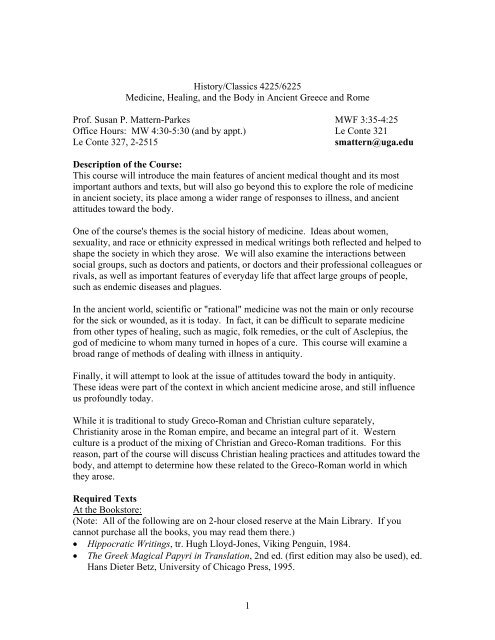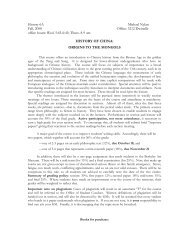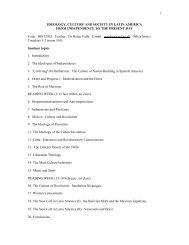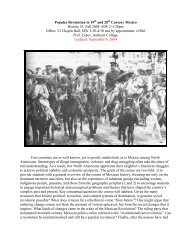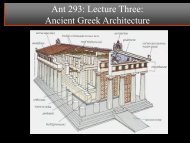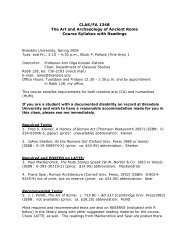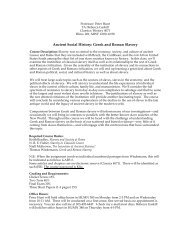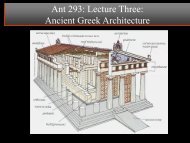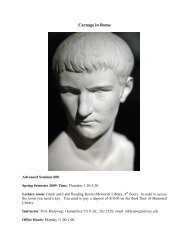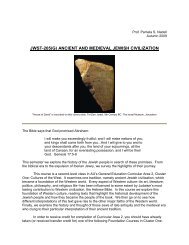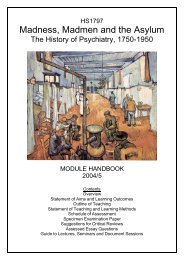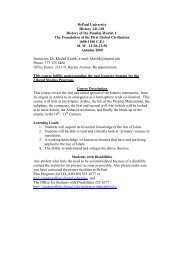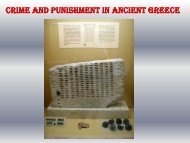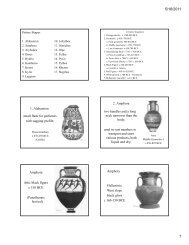Medicine, Healing, and the Body in Ancient Greece and Rome
Medicine, Healing, and the Body in Ancient Greece and Rome
Medicine, Healing, and the Body in Ancient Greece and Rome
- No tags were found...
Create successful ePaper yourself
Turn your PDF publications into a flip-book with our unique Google optimized e-Paper software.
course of <strong>the</strong> semester OR <strong>the</strong> first two class meet<strong>in</strong>gs FOR WHATEVER REASON. Ifyou miss more than 10 classes over <strong>the</strong> course of <strong>the</strong> semester for a compell<strong>in</strong>g medicalreason, see <strong>the</strong> Academic Affairs Office about a medical withdrawal.Email: The <strong>in</strong>structor relies on email to communicate with students outside of class.Each student is asked to submit an email address to <strong>the</strong> <strong>in</strong>structor <strong>in</strong> <strong>the</strong> first week ofclass <strong>and</strong> to check his or her email regularly (once a day is recommended). If you do nothave an email address, you can create one onl<strong>in</strong>e for free <strong>and</strong> check it from any computerwith <strong>in</strong>ternet access at <strong>the</strong> arches website, www.arches.uga.edu. Students are responsiblefor <strong>in</strong>formation dissem<strong>in</strong>ated by email.Comportment: Please do not eat <strong>in</strong> class (coffee or cold dr<strong>in</strong>ks is OK), sleep <strong>in</strong> class, orleave <strong>the</strong> room dur<strong>in</strong>g class (visit <strong>the</strong> restroom beforeh<strong>and</strong>). Turn off cell phones beforeenter<strong>in</strong>g <strong>the</strong> classroom. Do your best to arrive on time; quizzes will be given at <strong>the</strong>beg<strong>in</strong>n<strong>in</strong>g of class.Additional Requirements for Graduate Students: See below, pp. 17-19.Plagiarism: Plagiarism <strong>in</strong>cludes quot<strong>in</strong>g an author directly without enclos<strong>in</strong>g <strong>the</strong>passage <strong>in</strong> quotation marks <strong>and</strong> cit<strong>in</strong>g <strong>the</strong> source correctly, paraphras<strong>in</strong>g or summariz<strong>in</strong>gano<strong>the</strong>r author's work without cit<strong>in</strong>g <strong>the</strong> source correctly, present<strong>in</strong>g an idea as your ownthat was formulated by someone else, reproduc<strong>in</strong>g <strong>in</strong>formation compiled by ano<strong>the</strong>rauthor without cit<strong>in</strong>g <strong>the</strong> source correctly, buy<strong>in</strong>g papers, or copy<strong>in</strong>g papers. You mustcite your sources <strong>in</strong> footnotes or <strong>in</strong> paren<strong>the</strong>tical references every time you refer to <strong>the</strong>m,not just <strong>in</strong> a bibliography at <strong>the</strong> end of <strong>the</strong> paper. If I detect plagiarism university policyobligates me to report <strong>the</strong> <strong>in</strong>cident to <strong>the</strong> Office of <strong>the</strong> Vice President for Instruction <strong>and</strong><strong>the</strong> Academic Honesty Committee for review. Possible sanctions <strong>in</strong>clude a course gradeof F, suspension from <strong>the</strong> university, <strong>and</strong> expulsion.Grad<strong>in</strong>g:Participation, attendance, <strong>and</strong> read<strong>in</strong>g quizzes 15%Hour exams 20% eachPaper 20%F<strong>in</strong>al exam 25%Grad<strong>in</strong>g for Graduate Students:Participation, attendance, <strong>and</strong> read<strong>in</strong>g quizzes 10%Hour exams 15% eachBook review 15%Paper 25%F<strong>in</strong>al exam 20%Schedule of Read<strong>in</strong>g Assignments <strong>and</strong> Study Questions:The Greek "Rational" Tradition• Monday, Jan. 7. Introduction; discussion of syllabus.4
• Wed., Jan. 9. Homer <strong>and</strong> Greek culture. The Homeric body; Homeric medic<strong>in</strong>e.Read<strong>in</strong>g: Homer, Iliad, book 4 (<strong>in</strong> reader). Study questions: 1. Is <strong>the</strong>re "medic<strong>in</strong>e"<strong>in</strong> Homer? If so, what k<strong>in</strong>d?• Fri., Jan. 11. The Hippocratic corpus. Hippocratic ideologies. Read<strong>in</strong>g: The Natureof Man <strong>and</strong> Regimen for Health (<strong>in</strong> Lloyd). Study questions: 1. What are <strong>the</strong> basicelements of <strong>the</strong> author's <strong>the</strong>ory of <strong>the</strong> body? 2. On what does he base this <strong>the</strong>ory? 3.What o<strong>the</strong>r medical <strong>the</strong>ories or images of <strong>the</strong> body seem to have been prevalent <strong>in</strong> hisday? What is <strong>the</strong> relationship between health, disease, <strong>and</strong> lifestyle or behavior?What is considered a “normal” lifestyle?• Mon., Jan. 14. Causes of disease. Race <strong>and</strong> physiology. Read<strong>in</strong>g: Airs, Waters,Places (<strong>in</strong> Lloyd). Study questions: 1. What causes disease <strong>in</strong> this treatise? 2. Is<strong>the</strong>re a concept of "race" <strong>in</strong> this treatise? If so, what lies beh<strong>in</strong>d it?• Wed., Jan. 16. <strong>Medic<strong>in</strong>e</strong> <strong>and</strong> religion. "Rationalism." Read<strong>in</strong>g: Hippocratic corpus,The Sacred Disease (<strong>in</strong> Lloyd). Study questions: 1. What is <strong>the</strong> "sacred disease" <strong>and</strong>what causes it? 2. Whom is <strong>the</strong> author argu<strong>in</strong>g aga<strong>in</strong>st, <strong>and</strong> why is he so hostile? 3.What would you expect to occur if this doctor exam<strong>in</strong>ed you?• Fri., Jan. 18. Disease. Read<strong>in</strong>g: Hippocratic Corpus, Epidemics I (<strong>in</strong> Lloyd). Studyquestions: 1. What k<strong>in</strong>ds of diseases do <strong>the</strong> patients seem to have? 2. What do youth<strong>in</strong>k <strong>the</strong> doctor's purpose is <strong>in</strong> writ<strong>in</strong>g about <strong>the</strong>m?• Mon., Jan. 21: Mart<strong>in</strong> Lu<strong>the</strong>r K<strong>in</strong>g, Jr. Day• Wed., Jan. 23. Doctors <strong>and</strong> patients. Read<strong>in</strong>g: Hippocratic corpus, Epidemics III<strong>and</strong> Oath. Study questions: 1. Read<strong>in</strong>g <strong>the</strong> Epidemics closely, what can youdiscover about its author? 2. What k<strong>in</strong>ds of patients does this doctor have? What<strong>in</strong>formation does he provide about <strong>the</strong>m? Does he describe male <strong>and</strong> female patientsdifferently? 3. What k<strong>in</strong>d of practitioner is imag<strong>in</strong>ed <strong>in</strong> <strong>the</strong> Oath?• Fri., Jan. 25. Sex <strong>and</strong> reproduction. Read<strong>in</strong>g: Hippocratic corpus, The Seed <strong>and</strong> On<strong>the</strong> Nature of <strong>the</strong> Child. Questions: 1. How does conception take place, <strong>and</strong> whatdoes each parent contribute to <strong>the</strong> embryo? 2. What is <strong>the</strong> author's view of <strong>the</strong>female body?• Mon., Jan. 28. The plague of A<strong>the</strong>ns. Read<strong>in</strong>g: Thucydides, 2.47-55 (supplementaryreader). Study questions: 1. What causes <strong>the</strong> plague? 2. Why does Thucydidesdescribe <strong>the</strong> symptoms so carefully? 3. What are Thucydides' sources of <strong>in</strong>formation?4. What happens to human nature dur<strong>in</strong>g <strong>the</strong> plague?• Wed., Jan. 30. <strong>Body</strong> <strong>and</strong> soul. Read<strong>in</strong>g: Plato, Timaeus, 69a-92c (reader). Studyquestions: 1. What is <strong>the</strong> relationship between body <strong>and</strong> soul <strong>in</strong> <strong>the</strong> Timaeus? 2.What attitudes toward male <strong>and</strong> female are evident <strong>in</strong> <strong>the</strong> "Timaeus"?• Fri., Feb. 1. Lecture: Aristotle <strong>and</strong> medical science. Discussion of paper topics. Noread<strong>in</strong>g for today.• Mon., Feb. 4: Paper topics due. Anatomy <strong>and</strong> dissection. Hellenistic medic<strong>in</strong>e.Read<strong>in</strong>g: von Staden, Herophilus, <strong>in</strong> reader. Questions: 1. What were Herophilus'most important anatomical discoveries? 2. How did he make <strong>the</strong>se discoveries?• Wed., Feb. 6: Introduction to Soranus. The virg<strong>in</strong>; <strong>the</strong> female body. Read<strong>in</strong>g:Soranus, Gynecology, pp. 3-4, 8-34. Questions: 1. What is <strong>the</strong> relationship between5
virg<strong>in</strong>ity, puberty, <strong>and</strong> marriage? 2. What are Soranus' views on <strong>the</strong> female body? 3.What are his views on <strong>the</strong> social issues of marriage <strong>and</strong> childbear<strong>in</strong>g?• Fri., Feb. 8: The midwife <strong>and</strong> childbirth. Read<strong>in</strong>g: Soranus, Gynecology, pp. 5-7, 63-88. Questions: 1. What is Soranus' attitude toward abortion? 2. What medicalprofessionals are mentioned by Soranus <strong>and</strong> what do <strong>the</strong>y do? 3. What happens <strong>in</strong> atypical birth? 4. What is Soranus most concerned about <strong>in</strong> childbirth--what are <strong>the</strong>goals of <strong>the</strong> procedures he advocates?• Mon., Feb. 11: The nurse <strong>and</strong> <strong>the</strong> care of <strong>the</strong> <strong>in</strong>fant. Soranus, Gynecology, pp. 88-97,103-120.. Question: 1. Who is <strong>the</strong> wetnurse <strong>and</strong> what is her relationship to <strong>the</strong> child<strong>and</strong> its family? 2. What seems significant about <strong>the</strong> way small <strong>in</strong>fants are raised <strong>and</strong>cared for <strong>in</strong> Soranus' treatise?• Wed., Feb. 13: Diseases <strong>and</strong> <strong>the</strong>rapy of women. Read<strong>in</strong>g: Soranus, Gynecology, pp.128-154. Questions: 1. What k<strong>in</strong>ds of diseases does Soranus mention? 2. Whatk<strong>in</strong>ds of <strong>the</strong>rapy does he use, <strong>and</strong> how would you characterize <strong>the</strong>se <strong>the</strong>rapies? 3.What is hysteria? ***hysterical suffocation• Fri., Feb. 15: Hour Exam 1• Mon., Feb. 18: Dissection <strong>and</strong> vivisection. Anatomical demonstrations. Read<strong>in</strong>g:Galen, On anatomical procedures, book 7 (<strong>in</strong> reader). Questions: 1. Imag<strong>in</strong>e you arewatch<strong>in</strong>g one of Galen's anatomical demonstrations (dissections or vivisections).What is <strong>the</strong> sett<strong>in</strong>g? What is go<strong>in</strong>g on, <strong>and</strong> what is <strong>the</strong> effect of <strong>the</strong> performance? 2.What is Galen's <strong>the</strong>ory of respiration?• Wed., Feb. 20: Nature. Optics <strong>and</strong> <strong>the</strong> anatomy of <strong>the</strong> eye. Read<strong>in</strong>g: Galen, On <strong>the</strong>Usefulness of <strong>the</strong> Parts, book 10 (<strong>in</strong> reader). Questions: 1. What is Galen's <strong>the</strong>ory ofoptics <strong>and</strong> what are his sources of <strong>in</strong>formation? 2. What is his view of "nature"? 3. IsGalen religious?• Fri., Feb. 22: Annotated bibliographies due (graduate students only). Polemic.Case histories. Read<strong>in</strong>g: Galen, On <strong>the</strong> affected parts, book 5 (<strong>in</strong> reader). Questions:1. What is Galen's attitude toward previous medical writers (consider o<strong>the</strong>r read<strong>in</strong>gsfrom Galen here as well)? 2. What is <strong>the</strong> purpose of <strong>the</strong> case histories? 3. Whatk<strong>in</strong>ds of patient does Galen treat? 4. Read <strong>the</strong> story of Glaucon carefully. Whatseems significant about it?• Mon., Feb. 25: Galen's life. Galen as author. Galen <strong>in</strong> society. Read<strong>in</strong>g: Galen, Myown books <strong>and</strong> On <strong>the</strong> order of my own books (<strong>in</strong> reader). Questions: 1. Whatmotivates Galen to write? 2. On what subjects has he written? 3. What do <strong>the</strong>setreatises reveal about <strong>the</strong> process of writ<strong>in</strong>g <strong>and</strong> publication <strong>in</strong> antiquity? 4. What isGalen's place <strong>in</strong> society--with what k<strong>in</strong>ds of people does he <strong>in</strong>teract, <strong>and</strong> how?<strong>Medic<strong>in</strong>e</strong> <strong>and</strong> <strong>the</strong> <strong>Body</strong> <strong>in</strong> Roman Culture• Wed., Feb. 27: <strong>Medic<strong>in</strong>e</strong> on <strong>the</strong> farm. Roman identity. Read<strong>in</strong>g: Cato, OnAgriculture, selections (<strong>in</strong> reader). Questions: 1. Why do you th<strong>in</strong>k Cato <strong>in</strong>cludes thismaterial <strong>in</strong> his treatise? 2. How would you characterize <strong>the</strong> k<strong>in</strong>d of medic<strong>in</strong>e hedescribes--is it rational medic<strong>in</strong>e? Folk medic<strong>in</strong>e? Magic? How is it similar to, ordifferent from, Greek rational medic<strong>in</strong>e?6
• Thurs, Feb. 28: Semester Mid-Po<strong>in</strong>t• Fri., Mar. 1: Romans <strong>and</strong> Greeks. The history of medic<strong>in</strong>e. Read<strong>in</strong>g: Pl<strong>in</strong>y <strong>the</strong>Elder, Natural History, book 29 (<strong>in</strong> reader). Questions: 1. How does Pl<strong>in</strong>y perceive<strong>the</strong> history of medic<strong>in</strong>e? 2. What is his attitude toward doctors, toward Greeks, <strong>and</strong>toward Greek doctors? 3. What are <strong>the</strong> pr<strong>in</strong>ciples beh<strong>in</strong>d <strong>the</strong> <strong>the</strong>rapies herecommends?• Mon., Mar. 4: The history of medic<strong>in</strong>e. Practitioner <strong>and</strong> patient. Read<strong>in</strong>g: Celsus,On medic<strong>in</strong>e, proeemium <strong>and</strong> book 1. Questions: 1. How does Celsus perceive <strong>the</strong>history of medic<strong>in</strong>e? What are <strong>the</strong> ma<strong>in</strong> <strong>the</strong>mes <strong>in</strong> his account of it? 2. Do you th<strong>in</strong>kCelsus was a doctor? 3. What k<strong>in</strong>d of patient does Celsus imag<strong>in</strong>e?• Wed., Mar. 6: Surgery. Read<strong>in</strong>g: Celsus, On medic<strong>in</strong>e, book 7 (supplementalreader). Questions: 1. What k<strong>in</strong>ds of surgical operations does Celsus describe, <strong>and</strong>how are <strong>the</strong>y done?• Fri., Mar. 8: <strong>Body</strong> <strong>and</strong> soul <strong>in</strong> Epicurean philosophy. Read<strong>in</strong>g: Lucretius, On <strong>the</strong>Nature of Th<strong>in</strong>gs, book 3 (supplementary reader). Study questions: 1. What appearsto be <strong>the</strong> relationship between body <strong>and</strong> m<strong>in</strong>d or soul <strong>in</strong> Lucretius? You mightconsider whe<strong>the</strong>r <strong>and</strong> how his view differs from Plato's. 2. What appears to be <strong>the</strong>relationship between man <strong>and</strong> nature <strong>in</strong> Lucretius? 3. What metaphors <strong>and</strong> imagesstrike you as most <strong>in</strong>terest<strong>in</strong>g <strong>and</strong> unusual <strong>in</strong> this text? Why do you th<strong>in</strong>k Lucretiuschooses <strong>the</strong>se images?• Mon., Mar. 11: Roman martyrs. The body <strong>and</strong> <strong>the</strong> state. Stoics. Read<strong>in</strong>g: Tacitus,Annals 15.60-72, 16.9-35; Seneca, On Providence sections 2-3 (supplementaryreader). Study questions: 1. What is <strong>the</strong> pattern of <strong>the</strong> suicide-stories <strong>in</strong> Seneca <strong>and</strong>Tacitus? 2. What is <strong>the</strong> connection with philosophy? 3. Why do you th<strong>in</strong>k he isrecord<strong>in</strong>g this material? 4. What is <strong>the</strong> role of women <strong>in</strong> <strong>the</strong>se stories?The Cult of Asclepius• Wed., Mar. 13. Asclepius <strong>in</strong> mythology. Read<strong>in</strong>g: Asclepius, testimonia (NOT pagenumbers) 1-121, 627-706. Questions: 1. Who is Asclepius? 2. Exam<strong>in</strong>e <strong>the</strong>mythology of Asclepius carefully. What is <strong>the</strong> nature <strong>and</strong> purpose of myth?• Fri., Mar. 15: Outl<strong>in</strong>es due. Asclepius <strong>in</strong> <strong>the</strong> Mediterranean world. Read<strong>in</strong>g:Asclepius, section 7; browse testimonia (NOT page numbers) 707-844; readtestimonia 845-861. Questions: 1. Where would you f<strong>in</strong>d <strong>the</strong> cult of Asclepius? 2.What were <strong>the</strong> most famous sanctuaries, <strong>and</strong> what made <strong>the</strong>m special? 3. How <strong>and</strong>when did Asclepius arrive <strong>in</strong> <strong>Rome</strong>, <strong>and</strong> what is <strong>the</strong> significance of this?Mon., Mar. 18-Fri., Mar. 22: Spr<strong>in</strong>g Break• Mon., Mar. 25: Asclepius <strong>and</strong> pagan religion. Read<strong>in</strong>g: Asclepius, testimonia (NOTpage numbers) 482-617. Question: 1. What is "pagan religion?"• Wed., Mar. 27: The god of medic<strong>in</strong>e. Read<strong>in</strong>g: Asclepius, testimonia (NOT pagenumbers) 337-419. Questions: 1. What is <strong>the</strong> attitude of Galen <strong>and</strong> o<strong>the</strong>r doctors toAsclepius? 2. How does Asclepius go about heal<strong>in</strong>g his suppliants?7
• Fri., Mar. 29: The miracle-stories. Read<strong>in</strong>g: Asclepius, testimonia (NOT pagenumbers) 422-426. Questions: 1. How did <strong>the</strong>se stories arise, where would you f<strong>in</strong>d<strong>the</strong>m, <strong>and</strong> how did <strong>the</strong>y circulate? 2. What are <strong>the</strong> stories' most important narrativefeatures?• Mon., Apr. 1: Read<strong>in</strong>g: Aristides, Sacred Tales I (<strong>in</strong> reader). Questions: 1. Whatk<strong>in</strong>d of person is Aristides? What is his character, <strong>and</strong> what k<strong>in</strong>ds of th<strong>in</strong>gs mostconcern him? 2. What is his relationship to <strong>the</strong> god? 3. What do you make of hisdreams? 4. Why is Aristides writ<strong>in</strong>g?• Wed., April 3: Asclepius <strong>the</strong> physician. Read<strong>in</strong>g: Aristides, Sacred Tales II (<strong>in</strong>reader). Questions: 1. How does Asclepius cure Aristides? 2. What k<strong>in</strong>ds of <strong>the</strong>rapiesdoes Asclepius recommend, <strong>and</strong> how would you characterize <strong>the</strong>m? 3. What is <strong>the</strong>relationship among Aristides, his physicians, <strong>and</strong> <strong>the</strong> god?Magic• Fri., Apr. 5: Magic <strong>in</strong> <strong>the</strong> Roman world. Read<strong>in</strong>g: Greek Magical Papyri, pp. xi-xxii(Table of Spells); xli-lviii (Introduction). Questions: 1. Where do <strong>the</strong> papyri comefrom, what period do <strong>the</strong>y ma<strong>in</strong>ly date to, <strong>and</strong> what languages are <strong>the</strong>y <strong>in</strong>? 2. Whatwere <strong>the</strong> spells ma<strong>in</strong>ly supposed to do--what k<strong>in</strong>ds of spells survive? How would youdivide <strong>the</strong>m <strong>in</strong>to categories? 3. About what percentage are love spells? 4. About whatpercentage are heal<strong>in</strong>g spells?• Mon., Apr. 8: <strong>Heal<strong>in</strong>g</strong> spells <strong>and</strong> sicken<strong>in</strong>g spells. Read<strong>in</strong>g: Greek Magical Papyripp. 82-86 (PGM IV.2441-2621); 96-97 (PGM IV.3007-86); 166-7 (PGM XII.376-96); 120-121 (PGM VII.193-214); 123-4 (PGM VII.260-71); 226-229 (PDM xiv.554-93); 232-4 (PDM xiv.675-741); 242-4 (PDM xiv.935-1023); 247 (PDM xiv.1097-1103); 258-59 (PGM XX.4-19); 260 (PGM XXIIa.2-17); 267 (PGM XXXIII.1-25);277 (PGM XXXVI.320-32); 295-296 (PGM LXIII.21-28, LXV.1-7); 300 (PGMLXXXIII.1-20); 304-307 (PGM XCIV.10-60, XCV.1-18, XCVII.15-17, XCVIII.1-7,XCIX 1-3, C 1-7); 310-1 (PGM CIV.1-8, CVI.1-10); 313 (PGM CXIV.1-14); 314(PGM CXV.1-7); 316-321 (all). Questions: 1. How does magic work? Whatdist<strong>in</strong>guishes magic from, for example, medic<strong>in</strong>e or "religion"? 2. What specificmedical problems are <strong>the</strong> subjects of spells?• Wed., Apr. 10: Love spells. Read<strong>in</strong>g: Greek Magical Papyri, browse all love spells.Read carefully pp. 44-47 (PGM 4.296-466), 67 (PGM IV.1496-1595), 82-86 (PGM2441-2621), 88-90 (PGM IV.2708-84), 252-254 (PGM XVI 1-75), 266 (PGMXXXII.1-19, XXXIIa.1-25). Questions: 1. To what gender(s) do <strong>the</strong> lovers <strong>and</strong> <strong>the</strong>love objects belong? 2. What does <strong>the</strong> lover want? 3. What is <strong>the</strong> effect of <strong>the</strong> spell onits target? 4. What parts of <strong>the</strong> body are useful <strong>in</strong> spells?• Fri., Apr. 12: For today, choose one spell that you f<strong>in</strong>d especially <strong>in</strong>terest<strong>in</strong>g <strong>and</strong>write (TYPE, double-space) 1-2 pages comment<strong>in</strong>g on its significance. Be preparedto speak briefly to <strong>the</strong> class about your spell. This assignment will be graded as aquiz. (Students will only receive credit for assignments submitted ON TIME, INCLASS. Do not submit <strong>the</strong> assignment if you cannot attend class; it will not begraded).8
• Mon., April 15: Peer response exercise. Br<strong>in</strong>g 2 copies of your paper to class.<strong>Heal<strong>in</strong>g</strong> <strong>and</strong> <strong>the</strong> <strong>Body</strong> <strong>in</strong> Early Christian Culture• Wed., Apr. 17: <strong>Heal<strong>in</strong>g</strong> <strong>in</strong> <strong>the</strong> Gospels. Read<strong>in</strong>g: Mark (<strong>in</strong> reader). Questions: 1.What is <strong>the</strong> book of Mark about--what does it ma<strong>in</strong>ly conta<strong>in</strong>? 2. How does Jesus healpeople, <strong>and</strong> what k<strong>in</strong>ds of problems does he heal? 3. What is a typical heal<strong>in</strong>g eventlike?• Fri., Apr. 19: The resurrection. The Christian body. Read<strong>in</strong>g: Tertullian, On <strong>the</strong>resurrection of <strong>the</strong> flesh (<strong>in</strong> reader); Bible, I Cor<strong>in</strong>thians, chap. 15 (<strong>in</strong> reader).Questions: 1. What happens to <strong>the</strong> body at <strong>the</strong> resurrection? What type of body isresurrected? Do Tertullian <strong>and</strong> Paul agree on <strong>the</strong> answers to <strong>the</strong>se questions? 2. Whyis <strong>the</strong> resurrection of <strong>the</strong> body so important?• Mon., Apr. 22: Papers due. Christian martyrs. The suffer<strong>in</strong>g body. Read<strong>in</strong>g:Eusebius, History of <strong>the</strong> Church, selections (<strong>in</strong> reader). Question: 1. What areEusebius' sources of <strong>in</strong>formation? 2. What is <strong>the</strong> po<strong>in</strong>t of martyrology--why tell <strong>the</strong>sestories? What are <strong>the</strong>y supposed to accomplish?• Wed., Apr. 24: The ascetic body. Read<strong>in</strong>g: Athanasius, Life of Anhony, all (<strong>in</strong>reader). Questions: 1. In what ways does Antony's body suffer? 2. Is <strong>the</strong>re any sense<strong>in</strong> which <strong>the</strong> body is redeemed (or redeemable) <strong>in</strong> this story?• Fri., Apr. 26: Read<strong>in</strong>g: Review read<strong>in</strong>g for previous class. Questions: 1. What doesAntony do for people--what is his role <strong>in</strong> society? Specifically, a) what is <strong>the</strong> purposeor effect of his asceticism? <strong>and</strong> b) describe his role as a healer.• Mon., Apr. 29: Conclud<strong>in</strong>g remarks.F<strong>in</strong>al Exam: Mon., May 6, 8-11AM9
Step-By-Step Guidel<strong>in</strong>es for Term Paper AssignmentGoals of This Assignment:This assignment is designed to teach students to make a logical, rigorous, <strong>and</strong> conv<strong>in</strong>c<strong>in</strong>gargument from primary evidence. This is a skill not only required for competenthistorical writ<strong>in</strong>g, but for writ<strong>in</strong>g <strong>in</strong> any academic field or <strong>in</strong>deed <strong>in</strong> any professionalfield--you must be able to draw relevant conclusions from appropriate evidence <strong>and</strong>conv<strong>in</strong>ce o<strong>the</strong>rs of <strong>the</strong>ir validity. A fur<strong>the</strong>r goal of <strong>the</strong> assignment is to prepare historymajors for <strong>the</strong> senior <strong>the</strong>sis project (HIST 4990) by teach<strong>in</strong>g how to choose primarysources <strong>and</strong> develop an orig<strong>in</strong>al research topic.This assignment is NOT a test of your comprehension of <strong>the</strong> ma<strong>in</strong> <strong>the</strong>mes discussed <strong>and</strong>po<strong>in</strong>ts made <strong>in</strong> class (that is what <strong>the</strong> exams are for). You are to draw YOUR OWNconclusions, not simply repeat what <strong>the</strong> <strong>in</strong>structor has taught you or what you have heardor read elsewhere.Part I: Choos<strong>in</strong>g a Topic (due Monday, Feb. 4)1. Choose your primary source: When choos<strong>in</strong>g a topic, it is easiest to start by choos<strong>in</strong>gyour primary source. (If you are not sure what <strong>the</strong> difference between a primary <strong>and</strong> asecondary source is, see item f below). This will probably require some library research.When choos<strong>in</strong>g a primary source, bear <strong>in</strong> m<strong>in</strong>d <strong>the</strong> follow<strong>in</strong>g considerations.a) If you have some idea of <strong>the</strong> k<strong>in</strong>d of topic that <strong>in</strong>terests you, choose a primary sourcethat is likely to shed light on that topic.b) The selection of primary sources needs to be logical. If you choose to study <strong>the</strong> worksof two or more different authors, you need to be able to expla<strong>in</strong> why you are look<strong>in</strong>g at<strong>the</strong>se texts <strong>and</strong> not at o<strong>the</strong>r, similar works that were produced at <strong>the</strong> same time (that <strong>the</strong>yall happen to be on <strong>the</strong> course syllabus is not a good enough reason). If you choose tostudy selected works of a s<strong>in</strong>gle author, expla<strong>in</strong> why you are have chosen <strong>the</strong>se worksspecifically. It is simplest to settle on a s<strong>in</strong>gle work or <strong>the</strong> complete works of a s<strong>in</strong>gleauthor, but you may choose a more complex set of primary sources if you can justify itconv<strong>in</strong>c<strong>in</strong>gly .c) The primary source needs to be accessible to you <strong>in</strong> a language you can read.d) The primary source needs to be substantial enough <strong>in</strong> size to offer enough material fora 7-10 page study; however, it needs to be compact enough to allow you to read it <strong>in</strong> <strong>the</strong>amount of time available to you. Consider how much time you can devote to <strong>the</strong> project(obviously, <strong>the</strong> more time you spend on it, <strong>the</strong> more successful it is likely to be) <strong>and</strong> howcarefully you need to read <strong>the</strong> material. For some topics you may be able to skim parts of<strong>the</strong> text; for o<strong>the</strong>rs, you may have to read each l<strong>in</strong>e very carefully.10
e) Primary sources need not be literary; o<strong>the</strong>r types <strong>in</strong>clude, for example, vase pa<strong>in</strong>t<strong>in</strong>gsor <strong>in</strong>scriptions. If you use a non-literary primary source, show that a reasonably completedatabase (ei<strong>the</strong>r onl<strong>in</strong>e or <strong>in</strong> pr<strong>in</strong>t) is available to you.f) Carefully <strong>in</strong>vestigate <strong>and</strong> be aware of <strong>the</strong> editorial contribution to your edition of <strong>the</strong>primary source. Most of you will be us<strong>in</strong>g sources <strong>in</strong> translation, <strong>and</strong> that is important tobear <strong>in</strong> m<strong>in</strong>d as you write (arguments that depend on <strong>the</strong> nuances of <strong>in</strong>dividual words orphrases will not be conv<strong>in</strong>c<strong>in</strong>g if you cannot check <strong>the</strong> orig<strong>in</strong>al). Introductions to, <strong>and</strong>notes on, <strong>the</strong> text are obviously <strong>the</strong> product of secondary scholarship. Often, divisions<strong>in</strong>to books <strong>and</strong> chapters, chapter head<strong>in</strong>gs, titles of chapters, etc. do not belong to <strong>the</strong>orig<strong>in</strong>al text but were added by scholars <strong>in</strong> antiquity or by modern editors--be sure tocheck before you use <strong>the</strong>m <strong>in</strong> your argument.e) Note that sourcebooks, which by nature offer only a small selection of <strong>the</strong> availableevidence, usually heavily excerpted <strong>and</strong> edited, are normally not appropriate for researchprojects. If you see someth<strong>in</strong>g <strong>in</strong> a sourcebook that <strong>in</strong>terests you, track down <strong>the</strong> orig<strong>in</strong>altext.f) Primary vs. secondary sources: For <strong>the</strong> purpose of this class, primary sources are <strong>the</strong>ancient documents, texts, <strong>and</strong> artifacts that form <strong>the</strong> evidence on which we base ourconclusions. Secondary sources are modern studies or commentaries on <strong>the</strong> ancientevidence. Thus Soranus' Gynecology is a primary source, but Temk<strong>in</strong>'s <strong>in</strong>troduction toyour edition of <strong>the</strong> text, <strong>and</strong> <strong>the</strong> notes, are secondary sources.2. Choose your topic:a) If you have some idea of <strong>the</strong> k<strong>in</strong>d of topic that <strong>in</strong>terests you, choose a primary sourcethat is likely to shed light on that topic. But avoid form<strong>in</strong>g a firm idea of what your topicwill be until you have had time to look carefully at <strong>the</strong> primary source. The best topicsarise out of <strong>the</strong> little th<strong>in</strong>gs you notice that seem <strong>in</strong>terest<strong>in</strong>g or odd to you (e.g. femalepatients <strong>in</strong> <strong>the</strong> Epidemics have no names; Soranus prescribes read<strong>in</strong>g as a <strong>the</strong>rapy). Bypursu<strong>in</strong>g your thoughts about <strong>the</strong>se items, you can develop a topic suitable for substantialdiscussion (How does <strong>the</strong> author of Epidemics describe his female patients? Who areSoranus' patients?).b) Try not to br<strong>in</strong>g any prior assumptions to your read<strong>in</strong>g of <strong>the</strong> text. Forget everyth<strong>in</strong>gyou know about antiquity <strong>and</strong> be prepared to be surprised by what you read. If <strong>the</strong>primary evidence seems to contradict what you've heard <strong>in</strong> a lecture or read <strong>in</strong> a textbook,consider that <strong>the</strong> textbook or lecture may be wrong.c) Choose a topic that goes beyond <strong>the</strong> obvious. You must analyze <strong>the</strong> text <strong>and</strong> presentan argument about it, not just summarize what's <strong>in</strong> it.d) You must be able to prove your case us<strong>in</strong>g <strong>the</strong> primary evidence you have chosen tolook at. For this reason, topics that compare ancient phenomena with <strong>the</strong>ir modernequivalents usually present difficulties: how will you prove what you say about modernviews (which are often much more complicated than we realize)? Such questions are11
<strong>in</strong>terest<strong>in</strong>g <strong>and</strong> important to th<strong>in</strong>k about, <strong>and</strong> may be raised <strong>in</strong> a speculative way <strong>in</strong> <strong>the</strong>conclusion of your paper, but are not usually appropriate as research topics.e) Choose a historical topic. For this class, this means that you should be able to drawconclusions about ancient society based on your argument (<strong>the</strong>se may be tentative orspeculative, <strong>and</strong> your language should reflect that, but you should attempt <strong>the</strong>m <strong>in</strong> <strong>the</strong>conclud<strong>in</strong>g paragraph of your paper). Arguments that address only <strong>the</strong> literary or<strong>the</strong>oretical aspects of a text are <strong>in</strong>appropriate here.Submit a typed, double-spaced paragraph describ<strong>in</strong>g <strong>the</strong> topic you have chosen <strong>and</strong> <strong>the</strong>primary source you will be work<strong>in</strong>g with. If necessary, justify your choice of primarysources as described <strong>in</strong> 1b) above. You will be asked to meet with <strong>the</strong> <strong>in</strong>structor todiscuss your topic; br<strong>in</strong>g a second copy of <strong>the</strong> paragraph to this meet<strong>in</strong>g.Part II: Make an outl<strong>in</strong>e (due Friday, March 15)As you are read<strong>in</strong>g your primary source, take notes on notecards or on a computerdatabase program, mark <strong>in</strong> <strong>the</strong> marg<strong>in</strong>s (but DO NOT make marks <strong>in</strong> library books), flagpassages with post-it notes, or o<strong>the</strong>rwise keep track of material relevant to your paper(everyone has his/her own system). At <strong>the</strong> same time, th<strong>in</strong>k about how you will organize<strong>the</strong> material <strong>in</strong> your argument, <strong>and</strong> what evidence you will br<strong>in</strong>g to bear upon each po<strong>in</strong>t.It is important to do this while you are do<strong>in</strong>g <strong>the</strong> research, not afterwards, s<strong>in</strong>ceafterwards is too late--you will need to re-do <strong>the</strong> research to f<strong>in</strong>d <strong>the</strong> material that fitsyour argument. Keep track of your thoughts by mak<strong>in</strong>g an outl<strong>in</strong>e of <strong>the</strong> paper as you goalong.Submit a typed, double-spaced outl<strong>in</strong>e of your argument. Attach a revised description ofyour topic <strong>and</strong> a tentative title for <strong>the</strong> paper. These will be returned to you withcomments from <strong>the</strong> <strong>in</strong>structor. Students are encouraged, but not required, to meet with<strong>the</strong> <strong>in</strong>structor do discuss <strong>the</strong>ir outl<strong>in</strong>es.Part III: First Draft (due Monday, April 15)Br<strong>in</strong>g two copies of your first draft to class. You will be asked to share it with ano<strong>the</strong>rstudent <strong>in</strong> a peer review session.Part IV: F<strong>in</strong>al Draft (due Monday, April 22). You may be ready to submit <strong>the</strong> paper if:i) you have made substantial revisions to <strong>the</strong> first draft <strong>and</strong> are pleased with <strong>the</strong> results(that is, you feel <strong>the</strong> changes have resulted <strong>in</strong> major improvements); <strong>and</strong> ii) you havelooked over <strong>the</strong> f<strong>in</strong>al version a few times <strong>and</strong> t<strong>in</strong>kered with it, mak<strong>in</strong>g m<strong>in</strong>or adjustmentsthat improve <strong>the</strong> clarity of your writ<strong>in</strong>g. Virtually all good writ<strong>in</strong>g requires both types ofrevision. Even if you are not accustomed to revis<strong>in</strong>g your work, do so for this class.Citation:Remember: YOU MUST CITE <strong>the</strong> text every time you refer to it even if you don'tQUOTE from it. Arguments presented without evidence (i.e. properly cited references to<strong>the</strong> text) cannot be checked <strong>and</strong> will be ignored by your readers. Also remember that12
every time you use <strong>the</strong> exact words of ano<strong>the</strong>r writer, those words must be placed <strong>in</strong>quotation marks <strong>and</strong> <strong>the</strong> author must be cited correctly.<strong>Ancient</strong> history has its own, somewhat idiosyncratic methods of citation. S<strong>in</strong>ce you arenot us<strong>in</strong>g secondary sources for this paper, you only need to learn <strong>the</strong> method for cit<strong>in</strong>gprimary sources.The rules below may sound confus<strong>in</strong>g, but you will only need to master <strong>the</strong> few thatapply to your particular text. In general, tak<strong>in</strong>g careful notice of how o<strong>the</strong>r scholars referto your text will be <strong>the</strong> easiest way to discover <strong>the</strong> correct form for citation. If you haveany questions, see <strong>the</strong> <strong>in</strong>structor for help.If academic citation <strong>in</strong> general seems like a frustrat<strong>in</strong>g <strong>and</strong> unnecessarily complicatedbus<strong>in</strong>ess, it helps to keep <strong>in</strong> m<strong>in</strong>d <strong>the</strong> two basic purposes of citation: 1) to giveappropriate credit for words <strong>and</strong> ideas that are not your own (see <strong>the</strong> guidel<strong>in</strong>es onplagiarism on p. 4 of this syllabus); <strong>and</strong> 2) to allow <strong>the</strong> reader to check your evidenceeasily. If you keep <strong>the</strong>se two goals <strong>in</strong> m<strong>in</strong>d, you will not go far wrong.a) Abbreviations: you do not have to use abbreviations for authors or works yourself,but you should be aware as you do your research that <strong>the</strong>y are widely used by o<strong>the</strong>rscholars. The most common source of st<strong>and</strong>ard abbreviations for ancient authors <strong>and</strong>works is <strong>the</strong> Oxford Classical Dictionary.b) <strong>Ancient</strong> texts are not cited by page number. This is because many different editionsof a specific text usually exist, <strong>and</strong> it not helpful for a reader us<strong>in</strong>g one edition to have areference to page numbers <strong>in</strong> ano<strong>the</strong>r edition. <strong>Ancient</strong> texts, <strong>the</strong>refore, are normally citedby ancient book <strong>and</strong> chapter number, which will be <strong>the</strong> same <strong>in</strong> every edition (example:Thucydides 1.63). Modern translations of ancient works normally <strong>in</strong>dicate <strong>the</strong> ancientbook <strong>and</strong> chapter somewhere (<strong>in</strong> <strong>the</strong> marg<strong>in</strong>s, at <strong>the</strong> head of <strong>the</strong> page, or <strong>in</strong> <strong>the</strong> text itself)for this reason.c) Poetry is usually cited by ancient book <strong>and</strong> l<strong>in</strong>e number (example: Homer Iliad5.103-7). The problem here is that modern translations usually do not <strong>in</strong>dicate ancientl<strong>in</strong>e numbers. For this reason, if your primary source is a poem, you will need to cite <strong>the</strong>l<strong>in</strong>e number(s) of <strong>the</strong> modern edition you are us<strong>in</strong>g. Be sure that you <strong>in</strong>dicate somewherewhat this edition is (see item e below).d) Some prose works, such as those of Plato or Aristotle, are not normally cited byancient book <strong>and</strong> chapter number. Modern translations of <strong>the</strong>se authors will usually referto pages <strong>in</strong> <strong>the</strong> first authoritative modern edition of <strong>the</strong>ir works (example: Plato Republic360E-361B). For Galen, <strong>the</strong>y generally refer to <strong>the</strong> 1821 edition of Kühn, represented by<strong>the</strong> letter K (example: Galen, De methodo medendi, 10.582K; for those works not <strong>in</strong>Kühn's edition, see <strong>the</strong> <strong>in</strong>structor for fur<strong>the</strong>r help). For <strong>the</strong> Hippocratic corpus, <strong>the</strong>edition referred to is normally that of Littré. But if your translation uses some o<strong>the</strong>rmethod of referr<strong>in</strong>g back to <strong>the</strong> orig<strong>in</strong>al text, you may use that method.13
e) S<strong>in</strong>ce you will probably be us<strong>in</strong>g a modern translation of an ancient work, <strong>and</strong> willundoubtedly be quot<strong>in</strong>g from it, you will need to <strong>in</strong>dicate <strong>the</strong> edition <strong>and</strong> translation youare quot<strong>in</strong>g from <strong>in</strong> order to give appropriate credit to <strong>the</strong> translator. If you quote without<strong>in</strong>dicat<strong>in</strong>g a translator, <strong>the</strong> reader will assume that you did <strong>the</strong> translations yourself,which is a big problem if it is not true. The first time you quote directly from a text,<strong>in</strong>dicate <strong>in</strong> a footnote what edition you are us<strong>in</strong>g (ancient author, title, translator, city:publisher, date) <strong>and</strong> <strong>the</strong>n state that all fur<strong>the</strong>r quotations are from this edition. Althoughyou must refer to <strong>the</strong> modern translation for this purpose, I would still like you to cite <strong>the</strong>text by ancient book <strong>and</strong> chapter, so that I may check your references more easily when Igrade <strong>the</strong> paper.Note: If you quote from any part of a modern translation without <strong>in</strong>dicat<strong>in</strong>g somewherewhich translation you are us<strong>in</strong>g, po<strong>in</strong>ts will be deducted from your grade.Writ<strong>in</strong>g Problems?Good writ<strong>in</strong>g does not just happen; good writers work on <strong>the</strong>ir writ<strong>in</strong>g all <strong>the</strong> time, overyears. If you have not yet developed techniques to help you express your thoughtsclearly, here are some suggestions:1) Read <strong>the</strong> paper out loud to yourself. Listen to <strong>the</strong> words <strong>and</strong> sentences--do <strong>the</strong>y soundright <strong>and</strong> make sense? Would a listener be able to follow your argument?2) Stop by <strong>the</strong> writ<strong>in</strong>g center <strong>in</strong> 66 Park Hall <strong>and</strong> make an appo<strong>in</strong>tment. Tutors <strong>the</strong>re canhelp you evaluate your writ<strong>in</strong>g <strong>and</strong> suggest improvements. The writ<strong>in</strong>g center also hasl<strong>in</strong>ks to many useful resources (<strong>in</strong>clud<strong>in</strong>g an onl<strong>in</strong>e English grammar <strong>and</strong> style tips) on itswebsite, www.english.uga.edu/writ<strong>in</strong>gcenter/.3) Try <strong>the</strong> suggestions <strong>and</strong> exercises <strong>in</strong> Writ<strong>in</strong>g with Precision, by Jefferson Bates. It is<strong>in</strong> pr<strong>in</strong>t <strong>and</strong> available from amazon.com for a moderate price.4) Try <strong>the</strong> peer response exercise; come to <strong>the</strong> peer response class, or do this exercise onyour own time.5) Read your <strong>in</strong>structors' comments on your previous papers <strong>and</strong> really th<strong>in</strong>k about <strong>the</strong>m.If <strong>the</strong>re is someth<strong>in</strong>g you don't underst<strong>and</strong>, ask for clarification (this works best if you doit immediately after your paper is returned, while it is still fresh <strong>in</strong> your <strong>in</strong>structor'sm<strong>in</strong>d).6) My husb<strong>and</strong>, a professor <strong>in</strong> <strong>the</strong> English department, says "read Jane Austen!"7) If none of <strong>the</strong>se suggestions is work<strong>in</strong>g for you, <strong>in</strong>vest some time <strong>in</strong> f<strong>in</strong>d<strong>in</strong>g a book ortechnique that does work. In <strong>the</strong> long run, noth<strong>in</strong>g you can do <strong>in</strong> college is moreimportant, or more useful to whatever future career you plan, than develop<strong>in</strong>g a good,clear writ<strong>in</strong>g style.Ma<strong>in</strong> Factors Influenc<strong>in</strong>g Your Grade:a) Argument:i) Is <strong>the</strong> argument orig<strong>in</strong>al?ii) Is it conv<strong>in</strong>c<strong>in</strong>g?iii) Is it <strong>in</strong>terest<strong>in</strong>g--does it go beyond <strong>the</strong> obvious, does it analyze (ra<strong>the</strong>r thanjust summarize) <strong>the</strong> primary source? Is <strong>the</strong> problem or question it addresses important?b) Evidence.14
i) Is sufficient <strong>and</strong> conv<strong>in</strong>c<strong>in</strong>g evidence from <strong>the</strong> primary text provided to supporteach po<strong>in</strong>t?ii) Is <strong>the</strong> primary text used thoroughly <strong>and</strong> imag<strong>in</strong>atively?iii) Is <strong>the</strong> text cited properly? (Remember: YOU MUST CITE even if you don'tQUOTE.)c) Organization.i) Does <strong>the</strong> <strong>in</strong>troduction clearly state <strong>the</strong> problem to be addressed?ii)Does each paragraph contribute to <strong>the</strong> argument, <strong>and</strong> is it easy to follow <strong>the</strong>steps of <strong>the</strong> argument through each paragraph?iii) Does <strong>the</strong> conclusion go beyond merely re-stat<strong>in</strong>g what has already been said,to explore <strong>the</strong> full implications of <strong>the</strong> argument? Does it help <strong>the</strong> reader underst<strong>and</strong> <strong>the</strong>argument's larger significance?d) Style:i) Is <strong>the</strong> paper written <strong>in</strong> language that is clear <strong>and</strong> easy to underst<strong>and</strong>?ii) Are grammar, syntax, <strong>and</strong> typography correct?iii) Does <strong>the</strong> paper have a title that reflects its content?iv) Has it been pag<strong>in</strong>ated?15
General Guidel<strong>in</strong>es for PapersI. Presentation:A. Proofread <strong>and</strong> proofread aga<strong>in</strong>! Watch for grammar, syntax, <strong>and</strong> typographicalerrors. Make sure all your sentences read smoothly <strong>and</strong> make sense. Pay attention toproper use of apostrophes, commas, pronoun agreement, consistency of verb tense,spell<strong>in</strong>g, <strong>and</strong> o<strong>the</strong>r common grammatical mistakes--if <strong>the</strong> <strong>in</strong>structor has <strong>in</strong>dicatedgrammatical corrections, pay attention to <strong>the</strong>m. If you have questions, refer to anauthoritative manual of style or <strong>the</strong> grammar section of your dictionary. Try to rememberthat noth<strong>in</strong>g you write will be taken seriously if it conta<strong>in</strong>s grammatical errors.--If quot<strong>in</strong>g, it's especially egregious to make a mistake <strong>and</strong> especially important to makesure your quotations are exact.--Check <strong>the</strong> spell<strong>in</strong>g of all foreign names <strong>and</strong> words to make sure you've got <strong>the</strong>m right.B. Learn to pag<strong>in</strong>ate on <strong>the</strong> computer; always pag<strong>in</strong>ate all assignments. Type all<strong>in</strong>formation--don't h<strong>and</strong> write your name <strong>and</strong> so forth.C. Keep your paper to 10 pages. This may require some tough choices about what to<strong>in</strong>clude, but when such a limit is imposed on any project, it's important to stick to it.D. Double-space, use 12 po<strong>in</strong>t font <strong>and</strong> 1 or 1.25" marg<strong>in</strong>s.E. Staple. It's a good idea to buy a stapler at <strong>the</strong> bookstore. Few th<strong>in</strong>gs are morefrustrat<strong>in</strong>g than track<strong>in</strong>g down loose sheets of a student's assignment.II. Organization <strong>and</strong> content:A. Make sure your paper has a title that reflects its content!B. Make sure your <strong>in</strong>troductory paragraph expla<strong>in</strong>s <strong>the</strong> problem or question you areaddress<strong>in</strong>g <strong>and</strong> gives <strong>the</strong> reader a clear idea of your approach to <strong>the</strong> problem.C. Make sure <strong>the</strong> ma<strong>in</strong> po<strong>in</strong>t of each paragraph is clearly stated <strong>in</strong> <strong>the</strong> paragraph, at <strong>the</strong>beg<strong>in</strong>n<strong>in</strong>g, at <strong>the</strong> end, or both. Each paragraph should address <strong>in</strong> some logical way <strong>the</strong>problem described <strong>in</strong> (B)--don't w<strong>and</strong>er from your po<strong>in</strong>t.D. Do not make statements or generalizations without cit<strong>in</strong>g your source <strong>in</strong> support. Ifappropriate, quote passages, but use quotations spar<strong>in</strong>gly to save space; rememberhowever that you must cite <strong>the</strong> text (usually by book/chapter <strong>in</strong> paren<strong>the</strong>ses) even ifyou don't quote. Do not expect your reader to accept any statements that areunsupported by evidence.E. Generalizations <strong>and</strong> conclusions are more conv<strong>in</strong>c<strong>in</strong>g when <strong>the</strong>y come at <strong>the</strong> end.Don't make generalizations or draw conclusions <strong>in</strong> your <strong>in</strong>troduction or before provid<strong>in</strong>gevidence <strong>in</strong> support; <strong>the</strong> place for generalization <strong>and</strong> (cautious) speculation is <strong>in</strong> <strong>the</strong>conclud<strong>in</strong>g paragraph of your paper.F. Use your primary source thoroughly <strong>and</strong> imag<strong>in</strong>atively. Scrut<strong>in</strong>ize your source <strong>and</strong><strong>in</strong>tegrate as much evidence from it as possible <strong>in</strong>to your argument; don't just use a fewpassages. Especially if <strong>the</strong> amount of primary material is small, you must analyze it verycarefully. The more evidence you can f<strong>in</strong>d <strong>in</strong> support of your argument, <strong>the</strong> moreconv<strong>in</strong>c<strong>in</strong>g it will be.G. Avoid narrative summary. Focus on prov<strong>in</strong>g your ideas. You must argue/analyze notjust recapitulate what your source says.16
Additional Requirements for Graduate Students:Research Paper AssignmentA research paper of about 10 pages is required. Guidel<strong>in</strong>es for <strong>the</strong> undergraduate paperassignment should be followed with <strong>the</strong>se modifications:• Graduate paper topics should be orig<strong>in</strong>al; that is, <strong>the</strong>y must not duplicate <strong>the</strong> work ofano<strong>the</strong>r scholar. This is usually not a big problem if students use <strong>the</strong> method ofselect<strong>in</strong>g a topic recommended <strong>in</strong> <strong>the</strong> guidel<strong>in</strong>es for <strong>the</strong> undergraduate paper.• Graduate students must <strong>in</strong>corporate appropriate secondary scholarship <strong>in</strong>to <strong>the</strong>ir paperus<strong>in</strong>g footnotes <strong>and</strong> append an annotated bibliography to <strong>the</strong> paper ("annotated"means that each entry should be followed by a brief description of <strong>the</strong> book's orarticle's ma<strong>in</strong> argument). It is each student's responsibility to locate <strong>and</strong> use <strong>the</strong>relevant scholarship <strong>in</strong> every language that <strong>the</strong> student can read (traditionally,classical scholars <strong>in</strong>clude research <strong>in</strong> French, German, Italian, English, <strong>and</strong>sometimes <strong>in</strong> o<strong>the</strong>r European or non-European languages, but use whatever languagesyou know). Choose a topic that is focused enough that you can control <strong>the</strong> relevantscholarship.• Students should use a clear <strong>and</strong> consistent method of citation that conforms to <strong>the</strong>guidel<strong>in</strong>es of <strong>the</strong> Chicago Manual of Style or <strong>the</strong> MLA H<strong>and</strong>book (available onl<strong>in</strong>e at<strong>the</strong> library's "research help" website, http://www.libs.uga.edu/ref/citation.html).• A prelim<strong>in</strong>ary annotated bibliography is due on Friday, Feb. 22. To prepare thisbibliography, look for works that are authoritative <strong>and</strong> specifically relevant to yoursubject. Look for <strong>the</strong> most recent works first; <strong>the</strong>y can lead you to important olderworks, but <strong>the</strong> reverse is of course not true. Make sure that your bibliography<strong>in</strong>cludes both books <strong>and</strong> articles. The follow<strong>in</strong>g resources (<strong>in</strong> additional to <strong>the</strong> usualdatabases available on Galileo, such as PCI Web, Current Contents, etc.) may proveuseful:o The most recent issues of L'Année philologique, a comprehensivebibliographic <strong>in</strong>dex for <strong>the</strong> field of classics <strong>and</strong> ancient history, are searchableonl<strong>in</strong>e at http://callimac.vjf.cnrs.fr:8080/Dispatch_US.html. Spend some timewith this <strong>in</strong>dex to figure out how to use it effectively.o The tables of contents of over 100 important classics journals are <strong>in</strong>dexed <strong>in</strong> adatabase available from <strong>the</strong> University of Toronto athttp://www.chass.utoronto.ca/classics/resource.html. Choose "TOCS-IN"under "Source Specific" before you search.o The third edition of <strong>the</strong> Oxford Classical Dictionary (1997) <strong>in</strong>cludesbibliography at <strong>the</strong> end of each entry.o The websites Medic<strong>in</strong>a Antiqua/<strong>Ancient</strong> <strong>Medic<strong>in</strong>e</strong>(www.ea.pvt.k12.pa.us/medant/) <strong>and</strong> Diotima (http://www.stoa.org/diotima/)are good sources of bibliography.Book Reports:Each graduate student should choose one book from <strong>the</strong> list of "recommended additionalread<strong>in</strong>gs" (below) <strong>and</strong> prepare a 5- to 10-m<strong>in</strong>ute presentation for <strong>the</strong> class <strong>and</strong> also a 3- to5-page written report on <strong>the</strong> book to h<strong>and</strong> <strong>in</strong>. Only one student per book will be allowed;17
students will be asked to make <strong>the</strong>ir choices on Friday, Jan. 11. Presentations will bemade <strong>and</strong> written work submitted on <strong>the</strong> Wednesday or Friday (at <strong>the</strong> <strong>in</strong>structor'sdiscretion; please see her for schedul<strong>in</strong>g) of <strong>the</strong> week for which <strong>the</strong> additional read<strong>in</strong>g isassigned. If you choose an item from <strong>the</strong> "World History" read<strong>in</strong>g list, <strong>the</strong> <strong>in</strong>structor willschedule your presentation at her discretion. Please follow <strong>the</strong> follow<strong>in</strong>g guidel<strong>in</strong>es:• Reports should conta<strong>in</strong> three ma<strong>in</strong> parts:o The first should expla<strong>in</strong> <strong>the</strong> book's method <strong>and</strong> argument, <strong>and</strong> how it isorganized.o The second should <strong>in</strong>vestigate <strong>the</strong> scholarly response to <strong>the</strong> book--i.e. trackdown, read, <strong>and</strong> analyze reviews of <strong>the</strong> book; expla<strong>in</strong> <strong>the</strong> problems <strong>and</strong>strengths that o<strong>the</strong>r scholars have found <strong>in</strong> <strong>the</strong> book. For books on any topic<strong>in</strong> <strong>the</strong> field of classical antiquity, it will be easiest to locate reviews us<strong>in</strong>g <strong>the</strong>pr<strong>in</strong>t or onl<strong>in</strong>e version of L'Année philologique (see under "Research paperassignment," above). For reviews published up to 1993, PCI Web is also auseful resource. Additionally, most books are reviewed <strong>in</strong> an electronic seriescalled <strong>the</strong> Bryn Mawr Classical Review, which not <strong>in</strong>dexed <strong>in</strong> L'Année but issearchable at <strong>the</strong> University of Toronto website (also listed under "Researchpaper assignment," above). Gnomon, a German review journal, is alsosearchable on <strong>the</strong> same website.o In <strong>the</strong> third section, give your own critical analysis of <strong>the</strong> book. Checkreferences <strong>and</strong> <strong>in</strong>vestigate o<strong>the</strong>r scholarship if you have to.o For some very recent books, it may be difficult to locate reviews (though BrynMawr Classical Review will be a good bet even if <strong>the</strong> book has only been outfor a few months). In this case, limit or omit section two <strong>and</strong> exp<strong>and</strong> sectionthree.• The oral version of this report will be different from <strong>the</strong> written version--do not read<strong>the</strong> text of your paper to <strong>the</strong> class. Th<strong>in</strong>k about how to prepare an engag<strong>in</strong>g oralpresentation from notes or an outl<strong>in</strong>e.• Practice your oral presentation; make sure that it does not exceed 10 m<strong>in</strong>utes. Youwill be cut off after 10 m<strong>in</strong>utes.• Make sure <strong>the</strong> written report does not exceed 5 pages; edit drastically if you have to.• Type <strong>and</strong> carefully proofread your written report; double-space <strong>and</strong> use 12-po<strong>in</strong>t font.• Identify your book fully <strong>in</strong> a head<strong>in</strong>g at <strong>the</strong> top of <strong>the</strong> report.Recommended Additional Read<strong>in</strong>gsAll of <strong>the</strong> follow<strong>in</strong>g have been placed on reserve at <strong>the</strong> Ma<strong>in</strong> Library.• Recommended read<strong>in</strong>g <strong>in</strong> World History: The follow<strong>in</strong>g items have beenrecommended for <strong>the</strong> read<strong>in</strong>g list for <strong>the</strong> History department's new m<strong>in</strong>or field <strong>in</strong>"World History."o Guido Majno, The <strong>Heal<strong>in</strong>g</strong> H<strong>and</strong>: Man <strong>and</strong> Wound <strong>in</strong> <strong>the</strong> <strong>Ancient</strong> World,Cambridge: Harvard University Press, 1975.o Shigehisa Kuriyama, The Expressiveness of <strong>the</strong> <strong>Body</strong> <strong>and</strong> <strong>the</strong> Divergence ofGreek <strong>and</strong> Ch<strong>in</strong>ese <strong>Medic<strong>in</strong>e</strong>, Zone Books, 1999.o William H. McNeill, Plagues <strong>and</strong> Peoples, Garden City, NY: Anchor, 1976.• Recommended additional read<strong>in</strong>gs for each week: These assignments are designed to<strong>in</strong>troduce graduate students to basic scholarship on <strong>the</strong> texts, especially scholarship18
that might be useful for pedagogy (if <strong>the</strong>y decide to teach some of <strong>the</strong> material from<strong>the</strong> syllabus).o Week of Jan. 7-11: Jacques Jouanna, Hippocrates, tr. M.B. DeBevoise,Baltimore: The Johns Hopk<strong>in</strong>s University Press, 1999 (= Hippocrate, Paris:Fayard, 1992).o Week of Jan. 14-18: Mirko Grmek, Diseases <strong>in</strong> <strong>the</strong> <strong>Ancient</strong> Greek World,Baltimore: The Johns Hopk<strong>in</strong>s University Press, 1989.o Week of Jan. 21-25: Lesley Ann Dean-Jones, Women's Bodies <strong>in</strong> ClassicalGreek Science, Oxford: Clarendon, 1994.o Week of Jan. 28-Feb. 1: William H. McNeill, Plagues <strong>and</strong> Peoples, GardenCity, NY: Anchor, 1976..o Week of Feb. 4-Feb. 8: H. von Staden, Herophilus: The Art of <strong>Medic<strong>in</strong>e</strong> <strong>in</strong>Early Alex<strong>and</strong>ria, Cambridge University Press, 1988 (browse).o Week of Feb. 11-Feb. 15: Helen K<strong>in</strong>g, "Once Upon a Text: Hysteria fromHippocrates," <strong>in</strong> Hippocrates' Woman, London: Routledge, 1998, chap. 11.o Week of Feb. 18-22: O. Temk<strong>in</strong>, Galenism, Ithaca: Cornell University Press,1973.o Week of Feb. 25-Mar. 1: Mary Beagon, Roman Nature: The Thought of Pl<strong>in</strong>y<strong>the</strong> Elder, Oxford: Clarendon, 1992, or E.S. Gruen, Culture <strong>and</strong> NationalIdentity <strong>in</strong> Republican <strong>Rome</strong>, Ithaca: Cornell University Press, 1992.o Week of Mar. 4-Mar. 8: Al<strong>in</strong>e Rouselle, Porneia: On Desire <strong>and</strong> <strong>the</strong> <strong>Body</strong> <strong>in</strong>Antiquity, Cambridge: Blackwell, 1983.o Week of Mar. 11-15: Emma J. <strong>and</strong> Ludwig Edelste<strong>in</strong>, Asclepius: A Collection<strong>and</strong> Interpretation of <strong>the</strong> Testimonies, Baltimore: The Johns Hopk<strong>in</strong>sUniversity Press, 1945.o Week of Mar. 25-29: Ramsay MacMullen, Paganism <strong>in</strong> <strong>the</strong> Roman Empire,New Haven: Yale University Press, 1981.o Week of Apr. 1-5: Judith Perk<strong>in</strong>s, The Suffer<strong>in</strong>g Self: Pa<strong>in</strong> <strong>and</strong> NarrativeRepresentation <strong>in</strong> <strong>the</strong> Early Christian Era, London: Routledge, 1995.o Week of April 8-12: Christopher Faraone, <strong>Ancient</strong> Greek Love Magic,Harvard University Press, 1999.o Week of April 15-19: Morton Smith, Jesus <strong>the</strong> Magician, New York: Harper<strong>and</strong> Row, 1978.o Week of April 22-26: Peter Brown, The <strong>Body</strong> <strong>and</strong> Society: Men, Women, <strong>and</strong>Sexual Renunciation <strong>in</strong> Early Christianity, New York: Columbia UniversityPress, 1988.19


